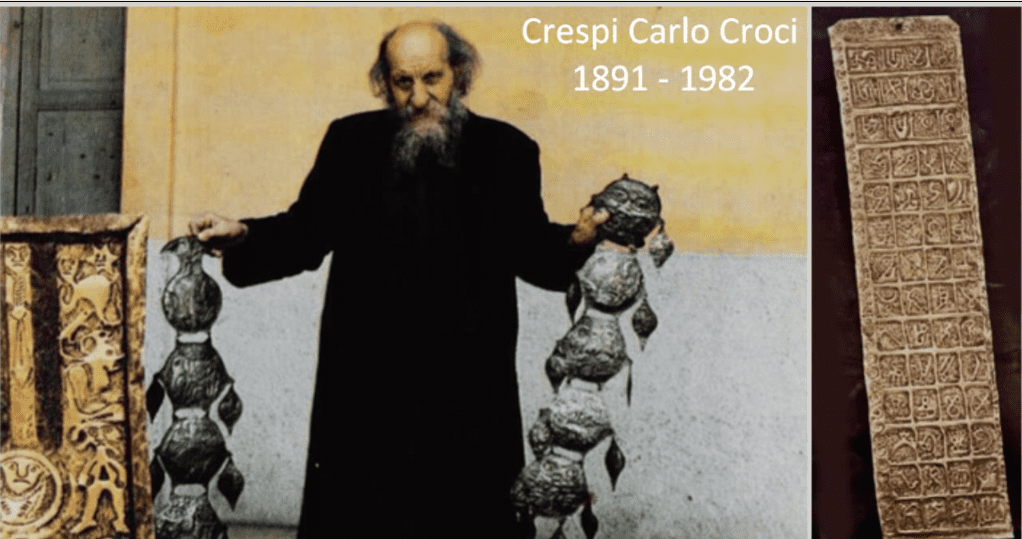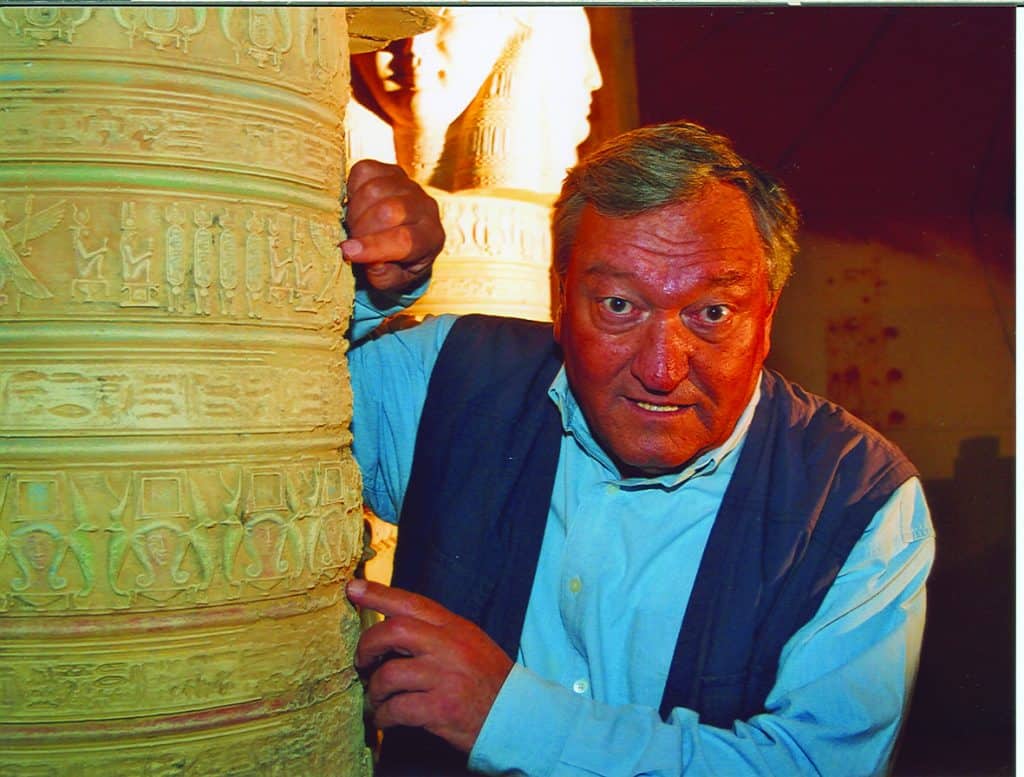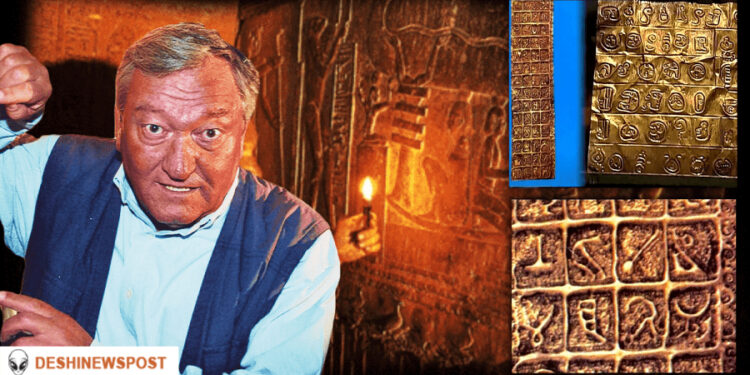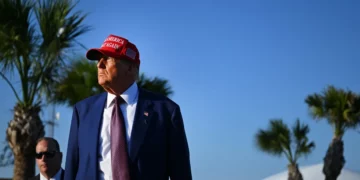A legend of “metallic library” is one of the few ancient mysteries that attracted the most renowned people such as Neil Armstrong to unravel it. It is believed that along with the lost gold, strange sculptures, and an artificial tunnel, the library is hidden underground in the jungle of Ecuador. Others believe that it could hold the information of Atlanteans or representatives of other ancient civilizations unknown to us. In his book “The Gold of the Gods,” Erich von Däniken told of a meeting with the old priest in Cuenca, Ecuador, who had a fabulous collection of ancient gold artifacts. He also talked about visiting a cave containing a “metallic library” and more gold with Juan Moricz, the cave’s discoverer.
In 1965, Juan Moricz, with the help of local Indians, discovered a huge underground network of tunnels of Cueva de los Tayos and an ancient library that consisted of thousands of books made of thin metal plates covered with strange unfamiliar symbols. The artifacts belonged to an ancient and highly developed culture unknown to us. Cueva de los Tayos is located in the high rainforest, 1.2 miles south of the Santiago River, and 2,600 ft west of Coangos River.
According to Daniken, this library was left to earthlings as a gift from alien astronauts. However, the mainstream authors and historians declared his book a hoax. New expeditions were organized to the Ecuadorian labyrinth, but no one found a trace of the library.

Reaching the most mysterious cave is not easy. The roads are full of potholes with deadly twists through the jungle above the Amazon Basin. After passing through the home of big black bullet ants and terrible humid weather, it is really challenging to go into the cave without taking permission from the local indigenous group of people known as “Shuar,” for whom the cave is sacred. The Shuar people perform spiritual ceremonies in the cave. They are known for shamanism, as well as dangerous Amazonian tribes who would not resist killing their enemies.
Father Carlo Crespi is a mysterious and controversial account of a priest in Ecuador involving claims of unknown civilizations, strange golden artifacts, a subterranean cave system containing a metallic library, depictions of strange figures connecting America to Sumeria, symbols depicting an unknown language, evidence of extra-terrestrial contact, and a Vatican conspiracy involving thousands of missing artifacts. He came to Ecuador in 1923. In 1927, he assisted to create a documentary about the Shuars and the first expedition to the Los Tayos cave was also carried out. Due to his hospitality and voluntary help, he received gifts from the Shuar community such as artifacts of gold and other precious metals: scepters, helmets, plates and discs.

It is odd that the symbols depicted on the metallic artifacts had nothing to do with the Shuars. Crespi believed that the ancient hieroglyphs, engraved on metal, kept the secret of the archaic language of antediluvian humanity. Unfortunately, his collection was destroyed in 1962 in the church fire, but what’s left was enough to intrigue the scientist. Some of the artifacts had a striking resemblance to other ancient cultures. There were statuettes and bas-reliefs that unambiguously resemble the finds of Ancient Egypt and Sumer.
Such stories encouraged explorers to visit the most remote place in South America. The earliest expedition to Tayos in Ecuador was carried out by Scottish engineer Stan Hall in 1976. He was accompanied by more than 100 people. Among them, there were British and Ecuadorian government officials, leading scientists and speleologists, British special forces, professional cavers, and astronaut Neil Armstrong, who served as the expedition’s Honorary President. It was one of the largest expeditions held by the top people in the government.
What they discovered during the expedition was a 1500 BC burial ground and stone passageways that seemed to have been cut artificially. A research was conducted at the cave, the scientists mapped the area and besides, archaeological discoveries were made. However, no gold was unearthed and they could not find any metallic library or any sign of an advanced civilization.

It turned out that Moricz showed Daniken only artifacts from the underground chamber and part of the entrance to it, but he kept the place of the Metallic Library secret. He died 15 years later in February 1991. And Hall tried to find the man who had told Moritz about the location of the metal library.
“Hall had a name—Petronio Jaramillo—but nothing more…” Finally, in September 1991, he found him and they met. Jaramillo stated that he had entered the library in 1946 when he was 17 years old. His uncle showed him the place. He had a friendly relation with the local Shuar. They even invited him to see a secret in gratitude for the kindness and goodness he had shown towards the tribe.
Jaramillo entered the system at least once after that. On that occasion, he saw a library consisting of thousands of large, metal books stacked on shelves, each with an average weight of about 20 kilograms, each page impressed from one side with ideographs, geometric designs and written inscriptions.
There was the second library, consisting of small, hard, smooth, translucent (what seemed to be crystal) tablets, grooved with parallel encrusted channels, stacked on sloping shelves of trestled units covered in gold leaves. There were zoomorphic and human statues (some on heavy column plinths), metal bars of different shapes, as well as sealed “doors”—possibly tombs—covered in mixtures of colored, semi-precious stones.”
“There was a large sarcophagus, sculpted from hard, translucent material, containing the gold-leafed skeleton of a large human being. In short, an incredible treasure, stored away as if hidden in preparation for some upcoming disaster.”
“On one occasion, Jaramillo took down seven books from the shelves to study them, but they were too heavy to carry. He never produced any physical evidence for his claims, which may explain why he wanted to live in the shadows of this story.”
Hall did ask him why he had never taken photographs. He said that it would not prove anything. Still, Jaramillo stated that he had left his initials in the seven books so that, if the library was ever discovered, it could be proved that it was he who had entered it.
Over the years, archaeologists have found many traces of previously unknown ancient cultures in Central and South America. Due to criticism Daniken faced in the press, he remained quiet on the topic for 37 years. In 2007, he published a book entitled “History Is Wrong,” in which he published all the documents of that time about what had really happened then. Daniken is convinced that the Metal Library does exist, and that unknown scripts exist as well.

























